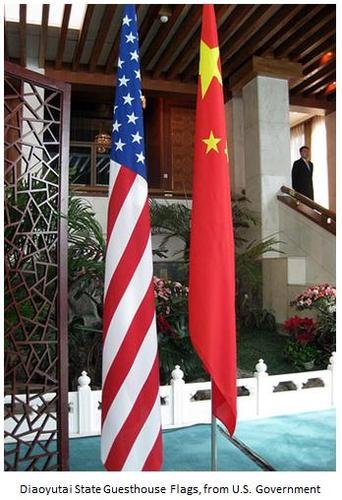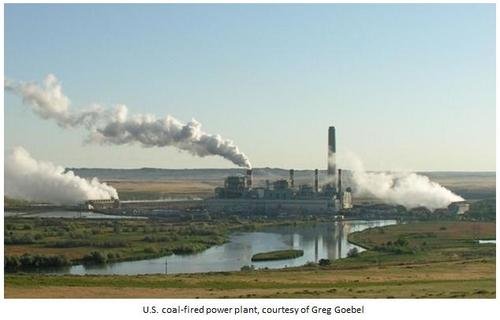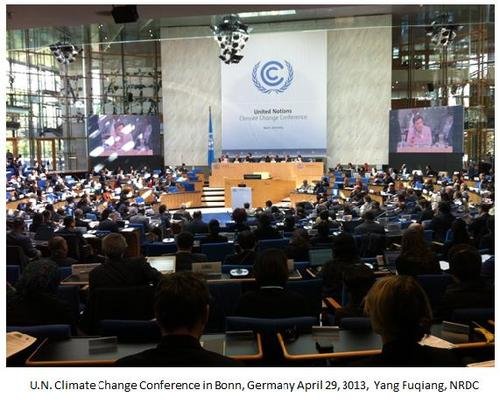The new Joint-U.S. China Statement on Climate Change, signed during Secretary of State John Kerry’s trip to China on April 13th, is extraordinarily symbolic because it recognizes that forceful cooperation and intensified action by the United States and China - the two largest emitters of greenhouse gas - is crucial to containing climate change. This new agreement raises the bar as it is supposed to "set the kind of powerful example that can inspire the world". This is an important new signal from these two key players, but only if it delivers specific actions that match the strong rhetoric.
 U.S. and China flag from U.S. Department of State under Creative Commons License
U.S. and China flag from U.S. Department of State under Creative Commons License
This isn't the first time that these two major countries have committed to work together to address climate change. Just before the Copenhagen Climate Summit the two countries agreed to "strengthen and coordinate our respective efforts". Since then, the U.S. and China have been partnering on a series of clean energy initiatives, though the level of funding and high-level support has dwindled. So skeptics rightly could view this agreement as little more than a repeat of the previous agreement, which was supposed to be an important breakthrough. But it still merits close attention, since real climate progress, including a strong international climate agreement, will only occur if key countries work to turn their climate commitments into specific actions at home. This joint commitment by the two largest GHG emitters to elevate climate change to a higher priority and put it on a fast track must ultimately be judged by the actions that are delivered, not by the words that are written.
The joint statement creates a new US-China Climate Change Working Group that will "begin immediately to determine and finalize ways in which they can advance cooperation on technology, research, conservation and alternative and renewable energy" to foster green and low-carbon economic growth. Many of the detailed recommendations in NRDC's 2009 report, Global Solutions to Global Warming: Recommendations for Leaders and Policy Makers in the United States and China, are still vitally important today. These range from specific actions for mobilizing the untapped potential of energy efficiency as a resource to investing in improving enforcement of environmental laws, an essential step in tackling air pollution as well.
As a start, here are our top recommendations for concrete actions the new U.S.-China Climate Change Working Group can promote:
I. Curb Carbon Emissions from the Power Sector and Other Major Emitters
Unconstrained coal use in the power sector and for other major stationary sources are major sources of climate and air pollution in China and the U.S., so tackling this pollution in both countries has to be a key priority. China's power sector accounts for about 50 percent of its coal consumption and emissions, with heavy industries such as iron and steel, cement and coal chemicals also constituting a large proportion of its coal consumption and pollution. In the US, even though the power sector has reduced its consumption of coal in the last two years, emissions from existing coal-fired power plants are still the largest source of U.S. carbon pollution. For both countries improving efficiency and expanding renewables is essential to curbing emissions from the power sector and industry.
China has improved the efficiency of its coal-fired power plants greatly since 2005, by retiring inefficient power plants with newer, more efficient power plants, and also improved the efficiency of its enterprises through the Top 10,000 Enterprises Program, provincial Demand Side Management programs, and other targeted industrial efficiency programs. It has also greatly expanded its use of wind power, and is set to similarly grow solar PV resources in the next five years, for both utility and distributed generation. The US also has significant success stories in decarbonizing the power sector and industry, such as California's Demand Side Management programs, the California Solar Initiative and the progress California is making to reach its target of obtaining 33% of its energy from renewables by 2020. New York state has also recently expanded its NY-Sun initiative, a public-private initiative that is providing $800 million for solar PV projects through 2015 and will provide $150 million in funding over the next 10 years. The US-China Climate Change Working Group could help to build connections between policymakers and developers in both countries, at both the national and subnational level, in sharing experiences in designing programs to expand efficiency and renewable energy and to integrate these expanded efficiency and renewable resources into energy and electricity planning.
 Power plant in the U.S. from Greg Goebel under Creative Commons License
Power plant in the U.S. from Greg Goebel under Creative Commons License
The US and China can also strengthen cooperation on market mechanisms such as cap-and-trade programs which can further incentivize clean energy investment. China has initiated carbon trading pilot programs in five cities and two provinces, which will begin trading later this year and are meant to be a precursor to establishing a national carbon trading program during the 13th Five Year Plan (2016-20). In the US, the Regional Greenhouse Gas Initiative and California's cap-and-trade program both provide valuable experiences in terms of developing effective cap-and-trade programs, including (1) developing accurate and comprehensive emissions inventories, including through use of continuous emissions monitoring systems, which will be helpful for China in developing either carbon trading or carbon tax regimes; and (2) designing emission trading systems so they achieve the optimal emissions reductions, especially through re-investment of program revenues into efficiency and renewables programs.
The Working Group can also explore other innovative mechanisms for reducing CO2 emissions from power generation. NRDC has developed a groundbreaking proposal for reducing CO2 and air pollutant emissions from the U.S. power sector by establishing carbon pollution standards for existing power plants. Our proposal accounts for differences among states, charts a path to affordable and effective emissions reductions by tapping into the ingenuity of local governments and the private sector to achieve emissions reductions through efficiency and renewables; and provides multiple compliance options, including cleaning up existing power plants, shifting power generation to plants with lower emissions or none at all, and improving the efficiency of electricity use. The experience in implementing carbon performance standards in the US could be especially helpful as China considers how it can most effectively and efficiently reduce its reliance on coal in the power sector.
The Working Group should also consider expanding the role that public-private partnerships, subnational cooperation and NGOs play in strengthening US-China cooperation on climate change. Such mechanisms can strengthen and accelerate exchanges on innovative policies, best practices and financing mechanisms. For example, China has been supporting combined heat and power for several years, an area that is also being actively promoted in the US. Similarly, developers in the US have developed innovative third-party financing mechanisms for distributed PV, while China is now actively seeking ways to scale up its domestic distributed PV market. Public-private partnerships, subnational cooperation and NGOs can serve as important bridges for expanded exchange.
II. Focus on Urgent Near-Term Action on Other Key Greenhouse Gases: HFCs and Black Carbon
The Working Group should focus on powerful greenhouse gases such as Hydrofluorocarbons (HFCs) and black carbon which have a potent near-term impact on the climate system (often called "short-lived climate forcers"). Joint action on these could be done quickly, with huge co-benefits for both sides, and with limited need for lengthy follow-on work as the solutions to both are well known in both countries.
The U.S. and China should agree to phase-down high-global warming potential HFCs under the Montreal Protocol. HFCs are “super” greenhouse gases that are used primarily as coolants in room and vehicle air conditioners. Avoiding the projected HFC growth by transitioning to safer chemicals that trap much less heat could avoid an amazing amount of climate-changing pollution – equal to 88 billion metric tons of CO2 worldwide through 2050. That's equivalent to twelve times the current annual carbon pollution of the U.S. Both the U.S. and China are major consumers and producers of HFCs, so they play an important leadership role in helping secure a global effort. More than 110 countries have already supported efforts to phase-down HFCs under the Montreal Protocol, but a proposed phase-down has yet to be implemented due to the resistance of China and India. The U.S. has begun to phase-down HFCs in new cars and is considering proposals to more broadly phase-down HFCs. NRDC and our partners in India have found that there are business reasons for India to phase-down HFCs and similar dynamics are at play in China as some of the companies in China are already developing joint ventures, implementing less damaging coolants, and eyeing the evolving market. The U.S. and China could help to unlock the stalemate at the Montreal Protocol and agree to phase-down HFCs at the this year's Montreal Protocol meeting.
The Working Group should also focus on implementation of actions to reduce black carbon from high-sulfur diesel fuels and vehicles. Black carbon is a much more powerful contributor to climate change than previously thought. In addition, diesel emissions are particularly toxic, contributing to increased asthma emergencies, cancers, heart attacks, and premature deaths. Fortunately, diesel pollution is a solvable problem. Lower-sulfur fuels, combined with emission control technologies that are only feasible with low-sulfur fuels, yields cleaner diesel vehicles, engines and ships that can be more than 90% cleaner than the models they replace. China recently set a timetable for adopting stricter diesel and gasoline fuel standards, so implementing those standards will be a priority. The U.S. is in the final stages of implementing low-sulfur fuel and vehicle standards.
Both countries should also work together to reduce high-sulfur diesel emissions from ships burning bunker fuel, the world's dirtiest transportation fuel. Unlike in the United States, where ship fuel will soon be capped at 1,000 parts-per-million (ppm), sulfur levels in the fuels that are burned at the ports of China and other developing countries are much, much higher. In those regions, the average container ship burns bunker fuel that averages 26,000 ppm. This too is a solvable problem that will yield major climate and air pollution benefits.
The Hong Kong government is beginning to explore with the nearby Chinese ports of Shenzhen and Guangdong the feasibility of proposing to the International Maritime Organization the establishment of a regional Emission Control Area (ECA) to cap sulfur content of shipping fuel at 0.1 percent within 200 nautical miles. ECAs, which are already in effect in the United States, Canada and northern Europe, provide the most protective clean air standards available under international law and would dramatically reduce polluting emissions from shipping.
III. Ensure Strong Environmental and Climate Safeguards for Shale Gas Development
The Working Group should develop partnerships with China's Ministry of Environmental Protection to ensure that strong environmental and climate safeguards are implemented for shale gas development in China, including reducing fugitive (non-combustion) methane emissions from the oil and natural gas sector. Having observed the rapid scale-up in the U.S. of natural gas from shale, China has established policies and joint ventures with the goal of adapting the technology and replicating the US experience. However, the US experience has also demonstrated the importance of establishing strong safeguards for shale gas development in order to protect and conserve precious water resources used in hydraulic fracturing, minimize methane and other air pollutant emissions, and protect public health. The U.S., for example, has finalized standards for volatile organic compounds that will also reduce methane emissions from new natural gas facilities.
The US-China Strategic and Economic Dialogue from May 2012 included an agreement to "strengthen future cooperation concerning shale gas development and regulatory and environmental frameworks" as part of the Memorandum of Cooperation on Shale Gas Resources between the State Department and the National Energy Administration. However, China's main environmental regulator, which will be charged with addressing the environmental impacts of shale gas development, is the Ministry of Environmental Protection, which currently lacks any environmental regulations or standards specific to shale gas. As a result, it would be very productive for the U.S. EPA, the Ministry of Environmental Protection, and NGOs to cooperate on environmental and climate regulatory frameworks for shale gas. Key areas for exchange of best practices include pre-drilling baseline water and air testing and environmental impact assessment, well integrity testing and monitoring, methane emissions controls, wastewater reduction, treatment and disposal, and monitoring and regulatory practices.
The US and China do not have to start from scratch in these efforts. Many of them are already being undertaken with varying levels of effectiveness and support. And the list of measures that the two could address could easily expand beyond these three specific actions to include strengthening cooperation on policies and financing mechanisms for increasing deployment and integration of renewables, more cooperation on building efficiency, and others. However, to be effective the US and China will need a stronger political commitment from the heads of government, scaled-up resources, and focused efforts to ensure that the actions are delivered on the ground in each country. NGOs like NRDC, along with public-private partnerships like the China-U.S. Energy Efficiency Alliance, can provide strong support to government efforts. Such assistance is especially important in light of governmental budgetary constraints.

Bonn climate negotiations © Yang Fuqiang/NRDC
Both sides have much to gain from working together to promote low carbon economic growth and environmental protection, such as better energy security, a cleaner environment, faster deployment of clean energy technologies, and increased business opportunities. The commitment by new leaders in both countries to fast-track and scale up their climate cooperation also provides a powerful signal to other countries in the international climate negotiations.
NRDC applauds China and the U.S. for pledging to intensify their efforts to jointly tackle global climate change and will do whatever we can to help accelerate the process. Because it can and must be done.
We hope that the actions from this commitment match the words and truly "Inspire the world".
(This post was co-written with Jake Schmidt, Alvin Lin, and Mona Yew.)
A shorter version of this post first appeared in China Dialogue: Are China and the US finally getting serious about climate change?


